The Royal Parks Central London
Former royal hunting grounds now a great place for visitors
Millions of Londoners and tourists visit the Royal Parks for free each year. Centuries ago when kings were absolute rulers and hunting was the main sport these parks were mostly the hunting grounds of people like Henry VIII.
It is hard to believe nowadays that in those days Hyde Park was in the countryside, outside the dense urban areas of London.
Unlike conventional public parks, the Royal Parks of London are owned by the crown and managed by a government agency called Royal Parks. Being historic places there are also many statues, fountains and other artwork waiting for you to discover.
We have a dedicated blog post for those who wish to explore the beautiful Royal Parks of London too.
St James's Park & Green Park Hyde Park & Kensington Gardens Regents Park & Primrose Hill

ROYAL PARKS SMALL GROUP BIKE TOUR
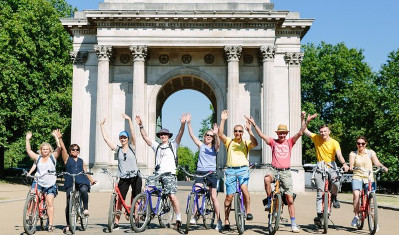
London Royal Parks Bike Tour including Hyde Park
• 4-hr morning or afternoon guided bike tour visiting Buckingham Palace, Kensington Palace & Princess Diana Memorial • Bike & helmet provided • Small group guided tour limited to 12
St James's Park & Green Park

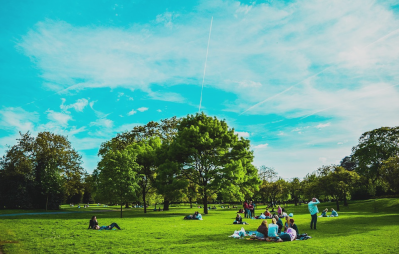
Surrounded by three palaces
St James's Park is the oldest Royal Park in London and is surrounded by three palaces. The most ancient is Westminster, which has now become the Houses of Parliament, St James's Palace and of course, the best known, Buckingham Palace.
For the purposes of this page we also treat Green Park as St James's Park, both seamlessly merge into one another with Green Park occupying the segment of park at its northern end. The park is open from 5am to midnight all year round.
The Changing of the Guard by St James's Park
For many people St James's Park is the most scenic of the royal parks. With Buckingham Palace and Horse Guards its also the scene of much pomp and ceremony including of course the Changing of the Guard. Horse Guards here has a lower key, and for many a much more satisfying Changing of the Guard than at Buckingham Palace.
What to do at St James's Park
Once inside St James's Park, at its eastern end the centrepiece is the lake attracting many birds. The lake has boards so you can try and identify some of the birds that can include Pelicans and much more commonly ducks and geese. The Pelicans are fed each day by wardens between 2.30 and 3pm.
There is a large cafe at the eastern end of the lake looking over the activities of the lake. The lake is left to the birds, there are no pleasure boats here like neighbouring Hyde Park.
History of St James's Park
At the north eastern tip of St James's park is the Citadel Building.
This windowless building is part of the Admiralty and was built in the 2nd World War to withstand a 1,000lb bomb.
Underneath the ground you are standing on is a web of underground tunnels connecting government departments, Buckingham palace and Downing Street.
It is thought there is a branch of the Victoria Line Underground between Green Park and Victoria stations that goes to Buckingham Palace in case of a high security event.
The Mall, the broad avenue that goes dead straight from Trafalgar Square to Buckingham Palace through St James's Park is thought to be earmarked for use as a landing strip if the nations elite need to be pulled out from London quick. The Mall is closed to traffic on Sundays and Bank Holidays.
St James's Park official website
Hyde Park & Kensington Gardens

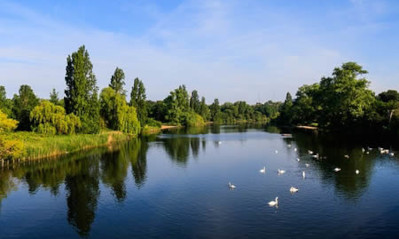
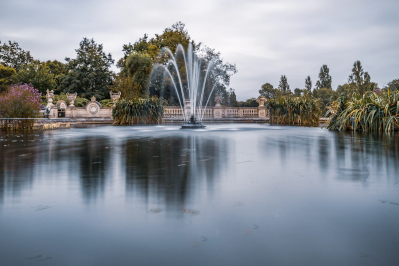
Hyde Park became a Royal Park in 1536 when the land, which was excellent for hunting, was acquired by King Henry VIII.
Hyde Park merges with Kensington Gardens
For many visitors it is slightly confusing as Hyde Park seamlessly merges into Kensington Gardens at its west end without any apparent boundary. We shall treat Kensington Gardens and Hyde Park as one park. Because of the size of the park you can have a major headline concert going on in one part of the park whilst in another you'll find a sleepy scene of people chilling out in a quiet corner.
The eastern end of the park is more open and 'playing field' grass. It tends to be a place where you will find impromptu games of soccer and people generally chilling out. The eastern end towards Park Lane tends to be where any big events are staged ranging from large concerts to fun runs.
Speaker's Corner
At the north eastern corner by Marble Arch is Speaker's Corner. Since 1872, people have been allowed to speak at Speaker's Corner each Sunday on any subject they want to. Anybody can bring a box, stand on it and preach without fear of arrest. There is a wide range of subjects but you can always count on a good proportion being religious and politically driven. Much of it is good natured, much of it reflects minority thought. Heckling provides more entertainment. If you are American, you may not feel among friends.
Most of the park is pedestrian only, though there is a road that crosses the park north - south. There are extensive tracks for horses and it is possible to hire horses from the stables. As you can imagine it is also a favourite place for joggers.
The Serpentine
The Serpentine is a large lake in the middle of Hyde Park that stretches westwards into Kensington Gardens finishing at the parks northern boundary by Lancaster Gate Underground Station.
The Serpentine has a nice cafe at its eastern end that overhangs the water (in the background of picture left). There is a lot of bird life no doubt attracted by the constant stream of people throwing them titbits. In the Hyde Park section of the Serpentine you can hire rowing boats, you get the picture?
The Diana Memorial
At the southern edge of the Serpentine by the bridge that carries the north-south road across the Serpentine is the Princess Diana Memorial opened by Her Majesty Queen Elizabeth II on 6th July 2004.
The design aims to reflect Diana's life, water flows from the highest point in two directions as it cascades, swirls and bubbles before meeting in a calm pool at the bottom.
At the north west corner of Kensington Gardens is the Princess Diana Memorial Playground, this is just inside the park gates opposite Queensway Underground.
The playground is also the north west point of the Princess Diana Memorial Walk. The seven-mile-long walk crosses St James's Park, Green Park, Hyde Park and Kensington Gardens. At its western end, Kensington Gardens is more 'wild' relatively to the playing field landscape of much of Hyde Park to the east.
Art & culture
Scattered around Kensington Gardens you will come across many statues and pieces of art. One of the most popular is the bronze of Peter Pan. J M Barrie, the author who created Peter Pan used to walk in this area and was inspired to write Peter Pan by his relationship with the Llewelyn Davies family that began in Kensington Gardens.
On the subject of art, along the park railings of Kensington Garden's northern boundary between Lancaster Gate and Bayswater you will find amateur artists displaying their work on a Sunday, though there is a lot of tourist tat as well.
At the southern end of Kensington Gardens is the Albert memorial opposite the Albert Hall. You can walk through to the South Kensington Museums and Harrods beyond that from here.
Regents Park & Primrose Hill
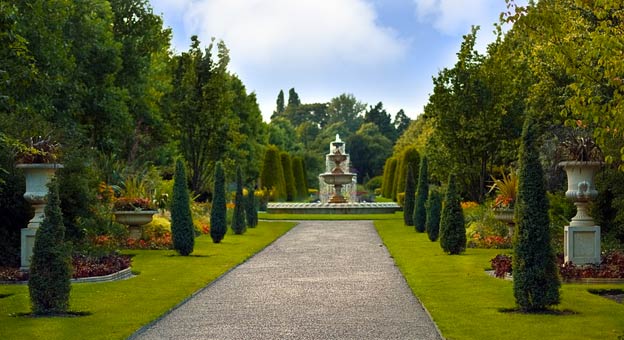
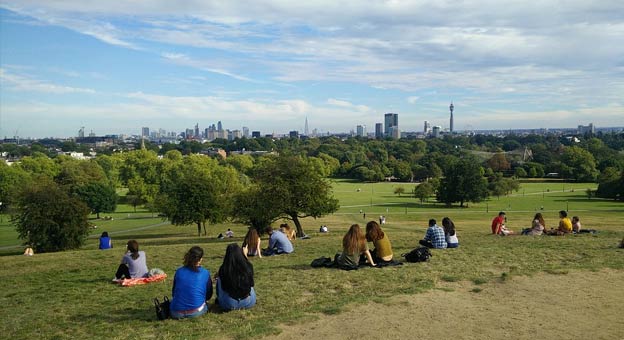
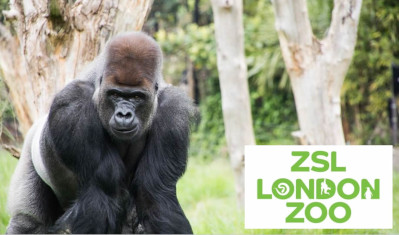
Henry VIII appropriated The Regent's Park for use as a hunting ground, which he considered to be an invigorating ride from Whitehall Palace, situated where Whitehall is today. In terms of tourists this is probably the least visited of the three royal parks in the centre of London, but it has much to offer. The park is open from 5am all year round. Closing times vary depending on the season.
What is at Regent's Park?
Lake and boating, gardens, places to eat, open air performances...
At the southern end of Regent's Park the park has plenty of formal gardens, the lake and ornamental gardens. As you head further north the park opens up into playing fields. On a Sunday here it will be full of soccer matches and have the feel of a local park for locals, rather than visitors.
The Hub is a modern circular building here that provides changing rooms, showers and such like for the host of activities organised. There is also a cafe here with views.
Many years ago the Royal Botanic Society laid out the Inner Circle at the heart of the park with lawns and a lake. Like St James's Park and Hyde Park there are many birds, Regent's Park is the centre for waterfowl breeding for The Royal Parks. Like Hyde Park, you can hire boats on the boating lake.
In the 1930s the Royal Botanic Society decided not to renew its lease and in its place the park laid out the formal rose beds of Queen Mary's Gardens at the southern end of the park. At about the same time, the Open Air Theatre began performances, which continue today and perform through the summer months.
Throughout Regent's Park at regular intervals are cafe's with names like the Honest Sausage and Cow & Coffee Bean. All refreshments are controlled by the Royal Parks.
London Zoo and Primrose Hill near Regent's Park
On the northern border of Regent's Park is the London Zoo. Opened in 1828, ZSL London Zoo is a large zoo with the full range of animals and birds you would expect as the main zoo for a large city.
On the northern boundary also is the Regents Canal. Pleasure trips go along here and there are nice walks along the tow paths. A nice short walk goes eastwards to Camden Lock, one of London's main markets.
North of the zoo and Regent's Park the ground rises up to Primrose Hill. It is not a steep hill and by climbing to the top you are rewarded with one of the best, and free views of London spread out before you. It would be a great place to bring a picnic on a summer evening.
On the few occasions it snows in London the hill is one of the favourite places for tobogganing in London. London Zoo was the World's first scientific zoo. Opened in 1828, it housed a collection of exotic animals that were studied by eminent scientists of the day.
POPULAR LONDON ATTRACTIONS - ADVANCE PURCHASE AND/OR FAST TRACK TICKETS
| London Eye | Amazing panoramic flight on the world's highest observation wheel. » Fast track tickets available. |
| The Shard | Tallest building in Western Europe with viewing of London from the top. » Fast track tickets available. |
| St Paul's Cathedral | Cathedral of the Diocese of London, venue for royal weddings. » Pre-book to guarantee entry. |
| Westminster Abbey | Along with St Paul's, England's main religious building.» Pre-book to guarantee entry. |
| Tower of London | Home of the Crown Jewels and a rich thousand year history. » Fast track tickets available. |
| Madame Tussauds | See wax statues of the most famous people in the world. » Fast track tickets available. |
| London Dungeon | The creepiest attraction in town, the London Dungeon. » Fast track tickets available. |
| Hampton Court Palace | Henry VIII Medieval Palace set in vast grounds. » Pre-book to save money. |
| The London Zoo | World class zoo in the centre of London. » Flexi tickets available. |












